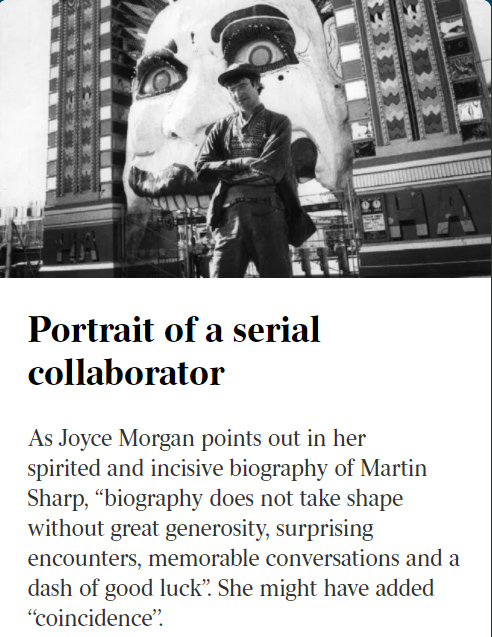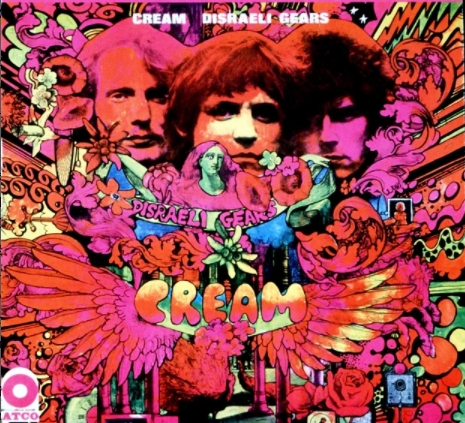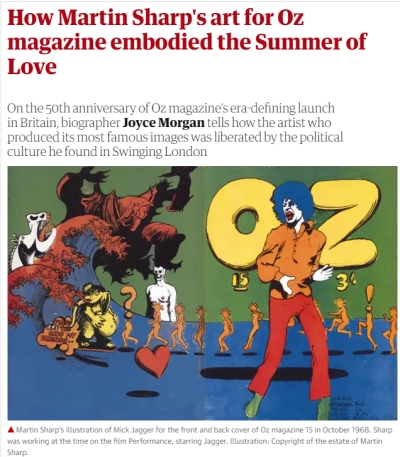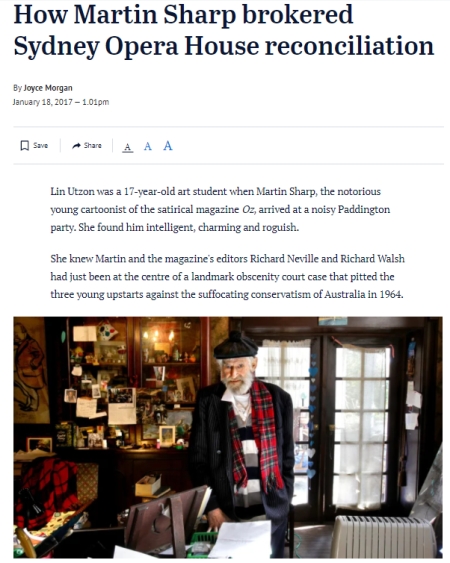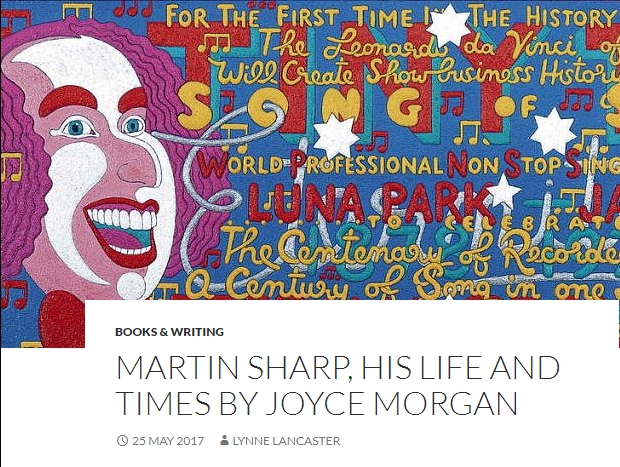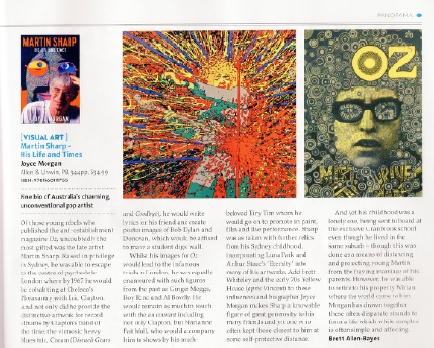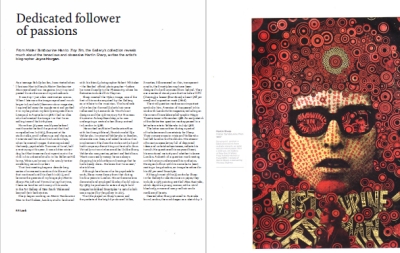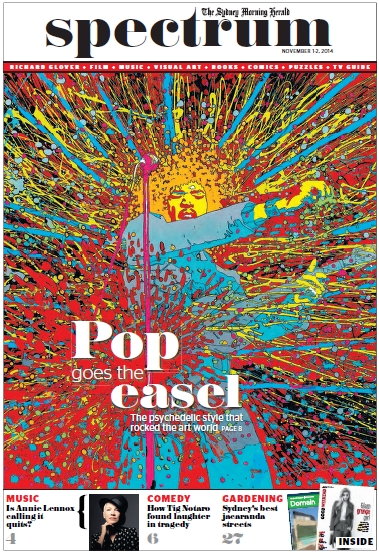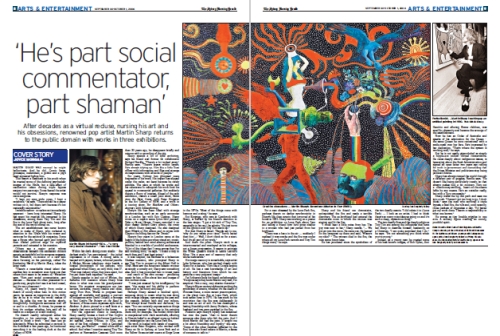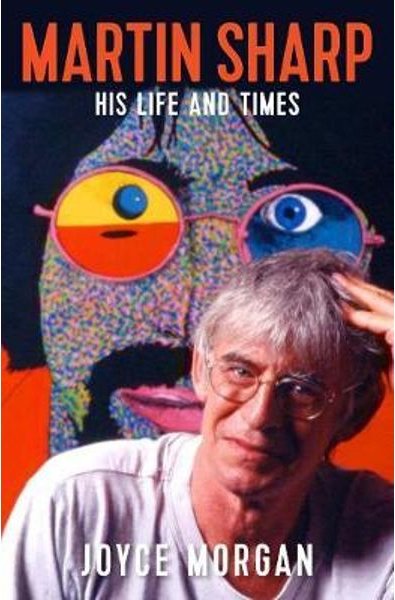
Martin Sharp was a Sydney-born visual artist whose Pop Art images helped define the Sixties.
Portrait of a serial collaborator
Review by Patricia Anderson The Australian 18 February 2017
As Joyce Morgan points out in her spirited and incisive biography of Martin Sharp, “biography does not take shape without great generosity, surprising encounters, memorable conversations and a dash of good luck”. She might have added ‘‘coincidence’’.
As a teenage fan of Bob Dylan, Morgan left Liverpool with her family for Sydney in 1968 carrying a magazine clipping of Mr Tambourine Man, a psychedelic poster of Dylan designed by an artist of whom she had never heard.
Two years earlier, that same artist, Martin Sharp, had travelled in the opposite direction, arriving in London as the music, art and fashion scenes exploded. He became lifelong friends with Eric Clapton and he took his first LSD trip watching Pink Floyd perform at the UFO Club.
See full article (paywall)
Life in a psychedelic cosmos
Review by Chris McAuliffe
The Sydney Morning Herald
9 March 2017
Morgan has secured striking insights from friends and lovers. In his later years, Sharp seems a biographer’s dream, combining biting self-examination with an almost excruciating determination to share his conclusions…
What makes Sharp so attractive to the biographer is also what makes his legacy so elusive. Active at the epicentre of ’60s counter-culture, Sharp flitted through Kings Cross coffee shops, New York recording studios and run-down London mansions, pausing occasionally (and understandably) in the Balearic Islands to catch his breath. His world was one of rock stars and models, cultural agitators and petty criminals, gurus and charlatans.
How Martin Sharp’s art of Oz magazine embodied the Summer of Love
Article by Joyce Morgan The Guardian 24 January 2017
A sinister gap-tooth smile grinned from the cover. Martin Sharp’s image announced the arrival of London’s Oz magazine, the exuberant herald of the hippy era.
The magazine would challenge the establishment, extol the virtues of drugs, sex and rock’n’roll and provoke a landmark obscenity case. Writers Germaine Greer, Lillian Roxon and Anthony Haden-Guest, who would go on to stellar careers, were among those who made early contributions.
But, 50 years on, it is not the articles in London Oz, but Sharp’s arresting images that remain compelling and ground-breaking. These were pivotal to magazine’s success and captured the spirit of a heady, utopian time.
How Martin Sharp brokered Sydney Opera House reconciliation
Article by Joyce Morgan The Sydney Morning Herald 18 January 2017
Lin Utzon was a 17-year-old art student when Martin Sharp, the notorious young cartoonist of the satirical magazine Oz, arrived at a noisy Paddington party. She found him intelligent, charming and roguish.
She knew Martin and the magazine’s editors Richard Neville and Richard Walsh had just been at the centre of a landmark obscenity court case that pitted the three young upstarts against the suffocating conservatism of Australia in 1964.
Radio National’s Books and Arts program
Interview by Sarah Kanowski ABC Radio National 19 May 2017
Martin Sharp’s images of Bob Dylan, Jimi Hendrix and naked flower children helped define the look of the 1960s and 70s.
The life Martin Sharp who lived in Sydney and London, partying with rock stars and models, dropping LSD and being charged with obscenity, seems almost a caricature of that era.
What was going on behind the psychedelic colours?
A new biography, Martin Sharp: His Life and Times, attempts to answer that question.
It’s written by Joyce Morgan, former arts editor of The Sydney Morning Herald.
A captivating new biography places Martin Sharp’s art in context
Review by Sama Hugo Artshub 10 April 2017
Joyce Morgan was drawn to Martin Sharp’s art before she knew who he was. This is unsurprising considering Sharp’s art circulated in many pop cultural forms over the course of his long and varied career.
T-shirts, album covers, cartoons, songs, and posters were all part of Sharp’s creative output, as well as painting, film and even residency at Sydney’s Luna Park funfair. Sharp operated in the popular imagination with boldness and wit, an artist for whom distinctions between high and low art were unnecessary.
Full of colourful details and eccentric characters, Morgan traces the artist’s path through the fascinating social milieu he lived in.
Martin Sharp, His Life and Times
Review by Lynne Lancaster Sydney Arts Guide 25 May 2017
This is a splendid, richly detailed biography of the iconic Australian artist Martin Sharp. He was the co-founder and principal cartoonist at Oz magazine, a song-writing partner to Eric Clapton, the producer of many famous pop, and much more.
Joyce Morgan, former Sydney Morning Herald arts editor and journalist, interviewed artist Martin Sharp frequently and intensively during the last decade of his life and unearthed a fascinating, complex man – from his involvement with Tiny Tim and Luna Park to Arthur Stace’s Eternity landmark scrawl, Picnic at Hanging Rock, and the Sydney Opera House.
Morgan also uncovers information about Sharp’s part in architect Jorn Utzon’s secret departure from Australia in 1966 and his eventual re-connection with the Sydney Opera House.
Fine bio of Australia’s charming unconventional pop artist
Review by Brett Allen-Bayes
Limelight magazine
January 2018
Of those young rebels who published the anti-establishment magazine Oz, undoubtedly the most gifted was the late artist Martin Sharp. Raised in privilege in Sydney, he was able to escape to the centre of psychedelic London where by 1967 he would be cohabiting at Chelsea’s Pheasantry with Eric Clapton.
And not only did he provide the distinctive artwork for record albums by Clapton’s band of the time, the virtuosic heavy blues trio Cream (Disraeli Gears), he would write lyrics for his friend and create poster images of Bob Dylan and Donovan, which would be affixed to many a student digs’ wall.
Dedicated follower of passions
Article by Joyce Morgan
Look magazine, Art Gallery of NSW
March/April 2017
As a teenage Bob Dylan fan, I was riveted when I first saw Martin Sharp’s Mister Tambourine Man reproduced in a magazine. I cut it out and pasted it onto the cover of my schoolbook.
When I later saw the image reproduced much larger in London’s Observer colour magazine, I squirreled away the supplement and packed it in my bag when my family emigrated from Liverpool to Australia in 1968. I had no idea who had created the image – or that I was sailing towards his birthplace.
More than 30 years would pass before I met the artist behind the portrait that had compelled me.
Portrait of the artist
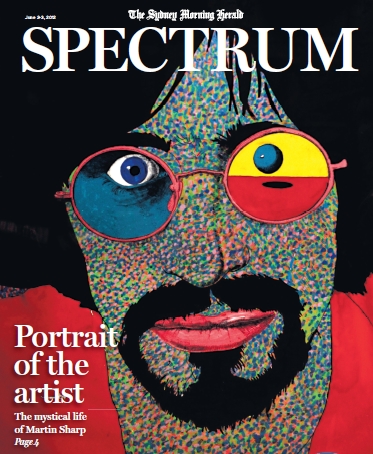
Article by Joyce Morgan
The Sydney Morning Herald
2 June 2012
The image of Jimi Hendrix, his guitar exploding with red-hot energy, is propped on an easel in Martin Sharp’s cluttered dining room. Assessing it across the table, Sharp is revisiting his celebrated work, whose riot of colour and exuberance defined the 1960s. The artist wants to fix the mistake he made when he portrayed the left-handed guitarist as right-handed.
Pop goes the easel
Article by Joyce Morgan
The Sydney Morning Herald
1 November 2014
A pensive cartoon girlfriend sheds a tear down a two-metre canvas. Gun-slinging Elvis Presleys stand with six-shooters at the ready. They are among the icons of pop art, the brash movement that erupted on the art scene like a fractious teenage gate crasher.
For some, the jumble of images – of soup cans and celebrities, comic-book characters and collaged cut-outs –were fun, sexy, expendable and, above all, popular. Others sniffed the winds of change and detected the stench of crass commercialism pervading the citadels of high art. With its effervescent imagery and kids’ colours, was it simply all surface and no substance?
He’s part social commentator, part shaman
Article by Joyce Morgan
The Sydney Morning Herald
30 September 2006
Martin Sharp was warned he might hallucinate. And he did. Comic faces, grotesque, malevolent, a goblin and a pig’s head appeared before him.
This wasn’t a flashback to his youth when he created some of the defining psychedelic images of the 1960s, but a side-effect of medication taken during triple bypass surgery two years ago.
Some feared the artist would not survive. Sharp’s response was more sanguine.
“I kept my eyes wide open. I kept a notebook,” he says. “There should be a paper written on it, but there isn’t because it’s not materially examinable.”
Invisible realms – or realms not immediately apparent – have long interested Sharp. He has spent his creative life immersed in his obsessions, among them Tiny Tim and the fire in the Luna Park ghost train, long after the rest of the world moved on.
Nightlife Radio Program

Sarah Macdonald
ABC Radio
10 June 2017
Australian artist Martin Sharp and his Oz magazine collaborators made their mark on the London and Sydney art scenes in the 1960s, famously being put on trial for obscenity more than once. Sharp’s subsequent career was vivid and varied, and he became a champion of the arts in Australia and beyond.
Joyce Morgan’s version of Martin Sharp presents an important portrait of the man and his times
Review by Jeannette Delamoir
Newtown Review of Books
29 June 2017
The cultural volatility of the 1960s demanded new ways to express its clashing ideals and philosophies. Late Sydney artist Martin Sharp was one of the key contributors to its visual language, working mainly in Sydney and London and creating cartoons, paintings, graphic design and collaborative ‘happenings’.
But he was a conundrum. A doctor’s son raised in privilege, he was anti-establishment. Although he was a sought-after artist, he resisted selling his work and believed art galleries were elitist and passé. A sensitive and generous person, he carelessly trashed apartments that friends had lent him; although shy, he collected people and lived and worked amid chaotic crowds of creative types, hangers-on, and – sometimes – criminals.
